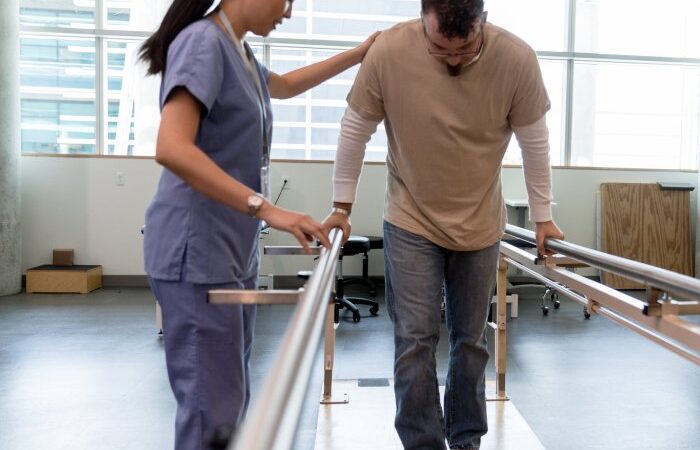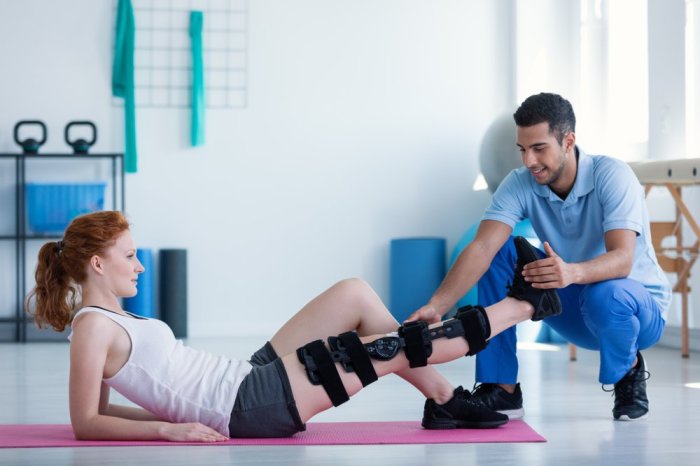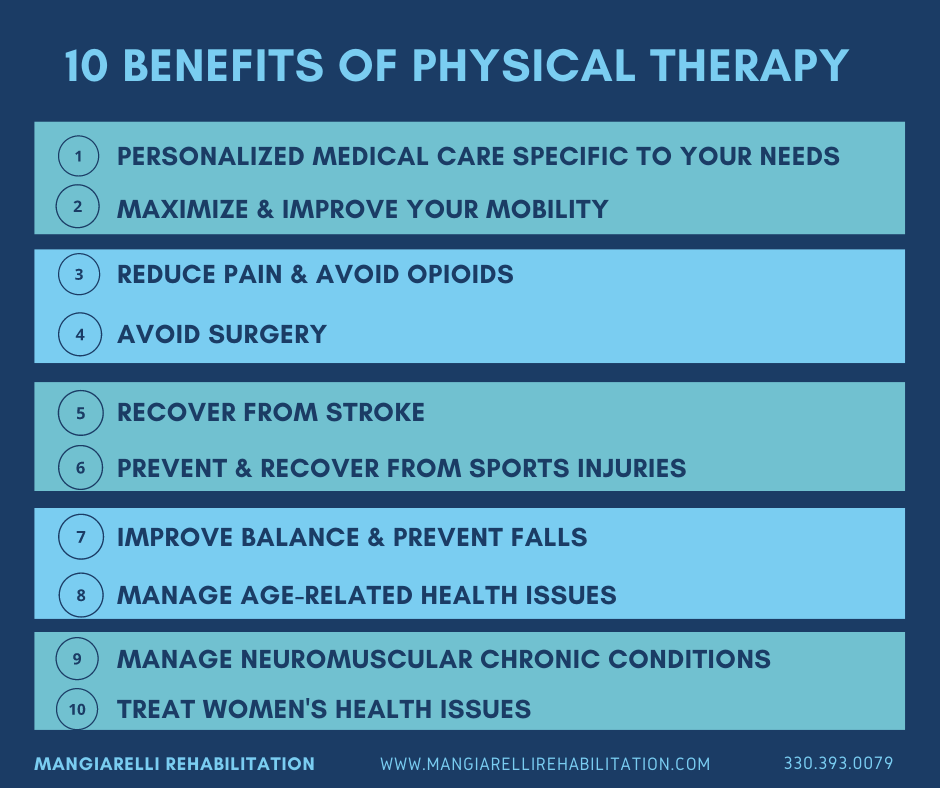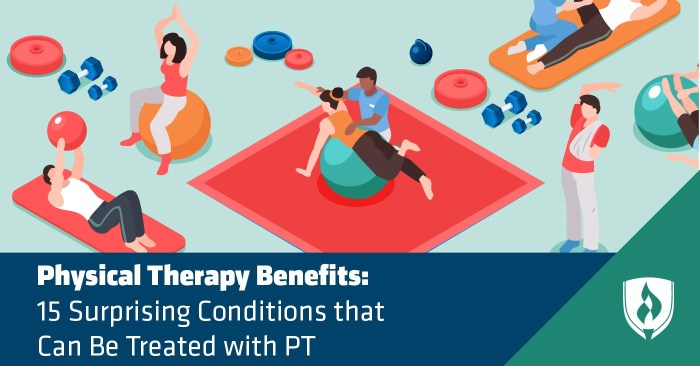Unlocking the Benefits of Physical Therapy

The benefits of physical therapy extend far beyond treating injuries. It’s a comprehensive approach to improving overall health, mobility, and well-being. Whether you’re dealing with chronic pain, recovering from surgery, or simply seeking to enhance your quality of life, physical therapy offers a personalized path to achieving your goals.
Physical therapists are highly skilled professionals who use a variety of techniques, including manual therapy, exercise prescription, and modalities like heat and cold therapy, to address your specific needs. They work closely with you to develop a customized treatment plan that considers your condition, lifestyle, and goals.
Pain Management and Relief

Physical therapy plays a crucial role in managing chronic pain conditions, empowering individuals to regain control over their lives and reduce reliance on medication. Through a comprehensive approach that combines manual therapy, exercise, and education, physical therapists help patients understand their pain, develop strategies for coping, and improve their overall well-being.
Modalities for Pain Management
Modalities are therapeutic tools that physical therapists utilize to address pain and inflammation. These modalities work by stimulating the body’s natural healing mechanisms and promoting relaxation.
- Heat Therapy: Applying heat to the affected area can relax muscles, increase blood flow, and reduce stiffness. This is particularly beneficial for conditions like muscle spasms and arthritis. Examples of heat therapy include hot packs, warm baths, and infrared therapy.
- Cold Therapy: Cold therapy, on the other hand, helps reduce inflammation, numb pain, and decrease swelling. Ice packs, cold compresses, and cryotherapy are common methods of cold therapy.
- Electrical Stimulation: This modality uses electrical currents to stimulate nerves and muscles, helping to reduce pain and improve muscle function. Transcutaneous electrical nerve stimulation (TENS) is a widely used form of electrical stimulation for pain management.
Exercises and Stretches for Pain Relief
Physical therapists design personalized exercise programs that address the underlying cause of pain and improve mobility.
- Strengthening Exercises: These exercises target specific muscle groups to enhance strength and stability. For example, strengthening the core muscles can help alleviate back pain, while strengthening the shoulder muscles can reduce neck pain.
- Stretching Exercises: Stretching helps improve flexibility, reduce muscle tension, and increase range of motion. Gentle stretches can be beneficial for conditions like arthritis and back pain.
- Aerobic Exercises: Engaging in low-impact aerobic exercises like walking, swimming, or cycling can improve cardiovascular health, increase endurance, and promote weight management, all of which contribute to pain reduction.
Injury Rehabilitation

Physical therapy plays a crucial role in helping individuals recover from injuries and regain their functional abilities. It involves a personalized approach to address the specific needs of each patient, encompassing a range of techniques and interventions designed to promote healing, reduce pain, improve mobility, and restore strength.
Post-Operative Rehabilitation
Physical therapy is an essential component of post-operative rehabilitation, particularly after procedures such as joint replacement and spinal surgery. The goal is to facilitate recovery, minimize complications, and optimize functional outcomes. Physical therapists work closely with surgeons and other healthcare professionals to develop a comprehensive rehabilitation plan tailored to the individual’s specific needs and surgical procedures.
Joint Replacement
Following joint replacement surgery, physical therapy focuses on restoring range of motion, strengthening muscles, and improving balance and coordination. This involves a gradual progression of exercises, starting with gentle movements and gradually increasing the intensity and complexity as the joint heals.
Spinal Surgery
After spinal surgery, physical therapy aims to alleviate pain, improve spinal stability, and restore functional mobility. This may involve exercises to strengthen core muscles, improve posture, and increase flexibility.
Exercises and Activities
Physical therapists use a variety of exercises and activities to promote recovery and restore function after an injury. These may include:
- Range of motion exercises: These exercises help to restore and maintain the flexibility and movement of the injured joint or area.
- Strengthening exercises: These exercises help to build muscle strength and endurance, which are essential for supporting the injured area and performing daily activities.
- Balance exercises: These exercises improve balance and coordination, reducing the risk of falls and enhancing overall stability.
- Proprioceptive exercises: These exercises focus on improving awareness of body position and movement, which is essential for regaining control and coordination.
- Functional exercises: These exercises mimic real-life activities, helping individuals regain the ability to perform everyday tasks.
Assistive Devices and Braces, Benefits of Physical Therapy
Physical therapists may recommend the use of assistive devices and braces to support the injured area, improve stability, and facilitate healing. These devices can provide additional support, reduce pain, and allow individuals to participate in rehabilitation activities more comfortably.
- Canes: Canes provide support and stability for individuals with weakness or pain in the lower extremities.
- Walkers: Walkers offer greater stability than canes and are often used by individuals with balance issues or significant weaknesses.
- Braces: Braces provide support and stability to injured joints, such as the knee, ankle, or wrist.
Improved Mobility and Function

Physical therapy plays a crucial role in improving mobility and function for individuals facing challenges due to neurological conditions or the natural aging process. By addressing underlying impairments, physical therapists help patients regain their independence and participate more fully in daily life.
Benefits of Physical Therapy for Mobility and Function
Physical therapy can enhance balance, coordination, and gait, leading to improved mobility and function. This is particularly beneficial for individuals with neurological conditions such as stroke, Parkinson’s disease, and multiple sclerosis, as well as those experiencing age-related declines in physical abilities.
- Balance and Coordination: Physical therapists employ various techniques to improve balance and coordination. These techniques include exercises that challenge the body’s sense of equilibrium, such as standing on one leg or walking on uneven surfaces. They also use proprioceptive exercises, which focus on strengthening the muscles that control balance and coordination.
- Gait Training: Gait training helps individuals with mobility issues improve their walking patterns. Physical therapists assess gait mechanics and identify areas for improvement. They may use assistive devices like canes or walkers, as well as specialized exercises, to enhance stride length, balance, and overall walking efficiency.
Examples of Exercises to Enhance Mobility
Physical therapists tailor exercise programs to meet individual needs and goals. These programs often incorporate a combination of exercises to improve strength, flexibility, and endurance, ultimately leading to increased mobility and independence.
- Strength Training: Strength training exercises target specific muscle groups to improve overall strength and power. Examples include weightlifting, resistance band exercises, and bodyweight exercises like squats and lunges.
- Flexibility Exercises: Flexibility exercises help improve range of motion and reduce stiffness. Examples include stretching, yoga, and Pilates.
- Endurance Exercises: Endurance exercises improve cardiovascular fitness and stamina. Examples include walking, swimming, and cycling.
Prevention and Wellness: Benefits Of Physical Therapy

Physical therapy is not just for treating injuries; it plays a crucial role in preventing them and maintaining overall health and well-being. By understanding how our bodies work and identifying potential risks, physical therapists can help us adopt healthier habits and reduce our chances of developing chronic conditions.
Promoting Healthy Lifestyle Habits
Physical therapists are experts in movement and can guide individuals in adopting healthy lifestyle habits, such as regular exercise and proper posture. They can tailor exercise programs to individual needs and goals, ensuring safety and effectiveness. They also emphasize the importance of maintaining proper posture throughout daily activities to prevent strain and injury.
Exercises and Activities for Enhanced Health
Here are some examples of exercises and activities that physical therapists recommend for improving overall health:
- Strengthening Exercises: These exercises target specific muscle groups to increase strength and endurance. Examples include squats, lunges, push-ups, and rows.
- Flexibility Exercises: Stretching exercises improve range of motion and flexibility, reducing muscle tightness and preventing injuries. Examples include yoga, Pilates, and dynamic stretches.
- Cardiovascular Exercise: Activities that elevate heart rate, such as running, swimming, and cycling, improve cardiovascular health, enhance endurance, and promote weight management.
Enhanced Quality of Life

Physical therapy goes beyond simply treating pain and restoring function; it plays a crucial role in enhancing your overall quality of life. By addressing the root causes of your physical limitations, physical therapy can positively impact your mental and emotional well-being, allowing you to live a more fulfilling and active life.
Improved Mental and Emotional Well-being
The positive effects of physical therapy extend beyond the physical realm, impacting your mental and emotional well-being in several ways.
- Reduced Pain and Anxiety: Physical therapy can significantly reduce pain levels, leading to a decrease in anxiety and stress. By effectively managing pain, physical therapy helps you feel more comfortable and confident in your daily activities.
- Improved Sleep Quality: Chronic pain can disrupt sleep patterns, leading to fatigue and irritability. Physical therapy can improve sleep quality by reducing pain and promoting relaxation.
- Increased Energy Levels: Physical therapy can help you regain strength and stamina, leading to increased energy levels and a more positive outlook on life.
Enhanced Social Participation and Independence
Physical therapy can empower you to participate more actively in social activities and regain independence in daily life.
- Increased Mobility and Strength: Physical therapy helps you regain strength, flexibility, and balance, allowing you to engage in activities you may have been limited by previously. This can include participating in hobbies, spending time with loved ones, or simply enjoying a walk in the park.
- Improved Functional Skills: Physical therapists can help you improve functional skills such as dressing, bathing, and cooking, making it easier to manage daily tasks and live more independently.
- Increased Confidence: As you regain strength and mobility, you may experience increased confidence and a sense of self-efficacy, which can positively impact your social interactions and overall well-being.
Empowerment and Goal Achievement
Physical therapy can empower you to take control of your health and achieve your personal goals.
- Personalized Treatment Plans: Physical therapists work with you to develop individualized treatment plans tailored to your specific needs and goals. This ensures that you receive the most effective and appropriate care for your condition.
- Active Participation: Physical therapy encourages active participation in your recovery. You work closely with your therapist to set goals, track progress, and make informed decisions about your treatment.
- Motivation and Support: Physical therapists provide motivation and support throughout your recovery journey. They celebrate your successes, address your concerns, and help you stay committed to your goals.
Outcome Summary

Physical therapy empowers you to take an active role in your health journey. It provides you with the tools and knowledge to manage pain, improve function, and prevent future injuries. By working with a physical therapist, you can unlock your body’s potential and experience a greater sense of independence, mobility, and overall well-being.
Comments are closed.